-

|
|
|
|
Development
of the
Chronomatic Movements
(Caliber 11, 11-I, 12 and 15)
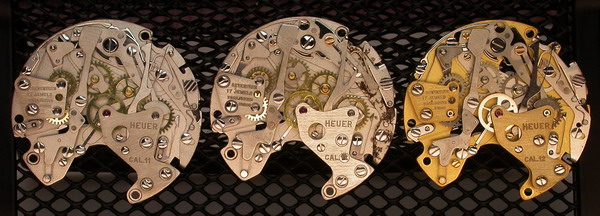
|
|
Ask
any vintage chronograph enthusiast what
happened on March 3, 1969, and he will
answer you quickly and with certainty,
"That was the day that the Heuer,
Breitling, Hamilton-Buren,
Dubois-Depraz partnership introduced
the world's first automatic
chronograph, with press conferences in
Geneva and New York City".
Ask
Hans Schrag (then Heuer's head
watchmaker in the United States) what
happened during the afternoon of March
3, 1969, just hours after the New York
City press conference, and he will tell
you of another memorable event, "That
was the time when the world's first
automatic chronograph came into the
service department for the first repair
of an automatic chronograph." Press
Hans for details, and some forty and
one-half years later, he will tell
describe for you the look of
disappointment from the owner of the
watch, the exact position of the
malfunctioning 8140 operating lever,
and his own shock to see an automatic
chronograph (and especially the oddity
of the crown at nine o'clock). Of
course, the owner of the watch was also
disappointed: he had won the watch in a
drawing at the New York City press
conference, but this marvelous new
watch didn't even make it to the end of
the afternoon before
malfunctioning.
Indeed,
it was the amazing speed with which the
Caliber 11 movement was developed that
allowed the Heuer-Breitling venture to
win the race to introduce this
horological marvel; this same speed
also resulted in a movement that
required immediate modification and
improvement.
This
webpage tells the story, not of how
Hans Schrag repaired the world's first
automatic chronograph -- that is
another story for another day -- but of
how the Caliber 11 series of movements
was developed and improved, beginning
in March 1969, to become a reliable
workhorse for a generation of amazing
chronographs.
|
|
|
|
Jeffrey
M. Stein
November 6, 2009
Copyright
Jeffrey M. Stein, 2009, all rights
reserved
|
|
|
|
Thanks
to Hans Schrag for providing the
technical and historical information
that allowed me to create this webpage;
thanks also for providing the three
chronograph modules show at the top of
this page. As I keep reminding
Hans: The more information he provides
for these sorts of webpages, the less
we will need to bug him with our dumb
questions (and the more he will enjoy
his retirement)!
Thanks
to Abel Court for providing many of the
photographs that illustrate this page,
and for helping me puzzle through so
many of the mysteries of the
Chronomatic movements. Never before has
the bi-metallic oscillating pinion been
photographed so
beautifully!
Thanks
to all the readers, writers, bloggers,
photographers, illustrators, dealers
and collectors who comprise the
OnTheDash / Chronocentric community.
Your passion inspires these
projects.
|
|
|
|
Background
of the Chronomatic Movements (Caliber
11 / Caliber 12)
As
described in our previous articles
about the development of the
Chronomatic (Caliber 11 / Caliber 12)
movements, the joint venture of Heuer,
Breitling, Buren and Dubois-Depraz "won
the race" to market the world's
first automatic chronographs, when the
Chronomatic chronographs were
introduced in March 1969 and offered
for sale to the general public during
the Summer of 1969. The Caliber 11
movement was an entirely new movement,
developed on a "white board" basis
by the joint venture partners, and in
order to win the race to market, the
movement was designed and developed
very quickly. In addition to the
innovation of being the first automatic
chronograph, the Caliber 11 had several
advanced technical features. In view of
the nature of the joint venture, the
speed with which the movement was
developed, and the technical features
of the Chronomatic watches, it is not
surprising that the Chronomatic watches
suffered from a variety of technical
issues when they were first sold to the
public.
This
webpage tells the next chapter of the
story -- how the Caliber 11 movements
were developed and improved after their
introduction in 1969, to become the
popular movements that powered a new
generation of chronographs for Heuer,
Breitling, Hamilton, Bulova, Zodiac and
several other brands. We will see that
while the Chronomatic partners lacked
the luxury of fully developing this
movement prior to its introduction,
they continued to develop these
movements so that they were the
workhorse movements of the 1970's and
continue as reliable movements, 40
years after their
introduction.
Caliber
11 -- The Early Problems
Some
of the technical problems arose with
the Caliber 11 movements arose from
decisions made in designing the
watches; others arose from poor
engineering or a lack of development of
the movement, as the partnership
competed to bring the first automatic
chronograph onto the market. The
following were among the most
significant design features of the
Caliber 11 movement, along with the
"technical" problems which were
attributable to these
features:
- Jumping
Hours. While most chronographs
of the period utilized a
“jumping” minute recorder
(meaning that the minute needle
jumped every minute) and a
“creeping” hour recorder
(meaning that the hour needle moved
continuoously during the hour), the
Caliber 11 used a jumping hour
recorder as well as a jumping minute
recorder. Accordingly, the hour
needle "jumped" every 30 minutes,
rather than moving continuously.
Having both the minute and hour
needles "jump" in one instant
required incrementally more power
than having the hour needle creep on
a continuous basis.
- Jumping
Date. The Caliber 11 was also
designed so that the date disk would
"jump" in a relatively short period
of time (beginning at 11:45 p.m.),
rather than beginning to change
earlier in the evening (for example,
at 10:30 p.m.). This jumping date
disk also required incrementally
more power than a disk that would
move more gradually over the course
of a longer period. Combined with
the jumping minutes and hours, the
movement required considerable power
to "jump" the date disc in only
15 minutes between 11:45 and
midnight.
- Banking.
In order to provide the power that
would be required for the Caliber 11
to operate -- with the chronograph
running, the needles jumping, and
the hour disk changing within a
relatively short period of time --
the Caliber 11 required a strong
mainspring. The mainspring used for
the Caliber 11 turned out to be too
strong, resulting in the problem of
"banking" (or
“rebanking”), meaning that
the balance wheel had too much
amplitude and caused the watch to
run too fast.
- Bi-Metallic
Pinion. The oscillating pinion
used in the Caliber 11 movement
(8086) was "bi-metallic", with a
brass head on a steel shaft. (The
Heuer-Breitling-Hamilton group used
a bi-metallic pinion, because at the
time that the Caliber 11 movement
was being developed, the group did
not have the ability to manufacture
a one-piece, all-steel pinion).
Becuase the head of the oscillating
pinion engages with the chronograph
runner wheel (8000) every time the
chronograph is started (and
disengages every time the
chronograph is stopped), there were
concerns that the pinion and wheel
would wear out prematurely.
The
Caliber 11-I Movement
As
a result of these technical problems
with the Caliber 11 movement, within a
year of its introduction, the
Chronomatic group
(Heuer-Breitling-Hamilton) made the
changes that resulted in the creation
of the Caliber 11-I movement. (We are
not certain, but can assume that the
"I" designation indicated that the
movement had been "Improved".) Changes
from the original Caliber 11 to the
improved Caliber 11-I included the
following:
- Creeping
Date Change. The date indicator
driving wheel (jumper) (2556) was
redesigned, so that the date changed
more slowly. On the Caliber 11-I,
the date change would begin at 10:30
p.m. and occurred over the next 90
minutes, with a "click" at
midnight.
- Lighter
(Weaker) Jumper Springs.
The jumper springs on the minute
(8270) and hour (8705) recorders
were made lighter (weaker), so that
less power was required for the
needles to jump each minute and each
30 minutes.
- Weaker
Mainspring. With less power
required to drive the date wheel and
the chronograph needles, the Caliber
11-I used a weaker mainspring than
the Caliber 11. (The improved
Caliber 11-I mainspring was housed
in a nickel-plated barrel, whereas
the Caliber 11 used a rose-colored
barrel). Changes in the balance
wheel also addressed the problem of
"banking".
- All
Steel Oscllating Pinion. The
oscillating pinion (8086) was
changed from being bi-metallic
(steel and brass) to solid steel. In
addition, the chronograph runner
wheel (8000), which mated with this
pinion, was changed from brass to a
nickel-silver alloy.
The
Caliber 12 Movement
Changes
from the Caliber 11-I movement to the
Caliber 12 movement included the
following:
- Faster
Beat. The "beat" of the
movement was changed from 19,800
vibrations per hour (VPH) in the
Caliber 11 and 11-I, to 21,600 VPH
in the Caliber 12. The change to a
higher beat was consistent with
trends in the watch industry,
suggesting a preference for higher
beat movements. The change in the
"beat" of the movement required
a re-design of the mainspring and
balance wheel, as well as
corresponding changes in the fourth
wheel (225), the escape wheel and
pinion (705) and the pallet
fork and staff (710). These
components are unique to the Caliber
12, and earlier parts for the
Caliber 11 or 11-I may not be
interchanged with these parts.
- Strengthening
Other Components. Certain
components of the Caliber 12
movement were made stronger or
otherwise improved. For example, the
fly-back lever (8180) was made
wider, as the narrower levers on the
Caliber 11 and 11-I had sometimes
failed. One of the most visible
changes from Caliber 11-I to Caliber
12 was in the reshaping and
enlargement of the hammer (8220). In
the Caliber 11 and
11-I movements, the hammer cam
jumper (8356) rested against
the lower section of this hammer
(8220), but there was nothing to
prevent the hammer cam jumper (8356)
from "jumping" out of position,
coming to rest above the hammer
(8220), which would result in the
start / stop / reset being
inoperable. In the Caliber 12
movement, the "head" of the
hammer (8220) was made
significantly larger, so that it
"sandwiched" the hammer cam
jumper (8356) in place and prevented
it from jumping out of position. A
large hole in the head of the hammer
(8220) allows for oiling of the area
of contact between the jumper and
the hammer, and is an easy way to
identify a Caibler 12
movement.
- Color
Change. The most visible change
from the Caliber 11 and
11-I movements to the Caliber
12 movement was that the main plates
of the movement were changed from a
nickel / silver color to a gold
tone. The Caliber 12 looks like a
gold tone movement, compared with
the silver tone of the Caliber 11
and 11-I. (There are, however,
certain Caliber 12 movements that
use the same nickel-silver plates as
the Caliber 11 and 11-I. In these
instances, the "11" on the
chronograph bridge (8500) is
over-stamped with a
"12".)
The
Caliber 15 Movement
In
order to be able to offer their
automatic chronographs at lower prices,
in 1972 Heuer and Breitling modified
the Caliber 12 movement so that it was
offered as the Caliber 15 movement. The
most obvious difference between the two
movements is that the Caliber 12
movement has a 12-hour recorder and a
30-minute recorder, whereas the Caliber
15 movement has only the 30-minute
recorder. [mention re running
seconds at ten o'clock] In addition
to the deletion of the 12-hour recorder
-- which saved considerably in the cost
of parts and labor -- the following
changes from the Caliber 12 to the
Caliber 15 allowed the Caliber 15 to be
produced on a more economical
basis:
- Brass
Balance Wheel (rather than
Glucydur). The Caliber 12
movement used a Glucydur balance,
while the Caliber 15 movements used
a brass balance. Glucydur is an
tradename for an alloy made of
berrylium, copper and iron. This
material features excellent hardness
and high stability over a range of
temperatures, and is resistant to
deformation or damage.
- KIF Shock
Protection (rather than
Incabloc). The Caliber 12
movement used the Incabloc shock
protection system, whereas the
Caliber 15 movement used the
KIF system. The primary
difference between the Incabloc and
KIF shock protection systems is
in the shape of the spring which
holds the cap jewel in place; both
springs are hinged so that the jewel
can be removed without removing the
spring.
- Deletion
of Isochron Regulation
(Micro-Regulation). The Caliber
12 movement used the Isochron micro
regulation system, which derived
from the regulation system used in
the Buren Intramatics. The Isochron
system uses two sets of eccentric
screws and forked levers to move the
regulator (307/1) and the hairspring
stud (364) with great accuracy. This
system allows the adjuster to put
the watch into near perfect beat and
regulation without many frustrating
back and forth movements of the
regulator (curb pins) and stud
carrier. This regulation system is
not used on the Caliber 15 movement,
making it more difficult for the
watchmaker to regulate the watch
accurately.
The
use of the Caliber 15 movement rather
than the Caliber 12 movement allowed a
Caliber 15 Carrera to have a retail
price of $170 (versus $185 for the
Caliber 12 model); the Cal 15 Autavias
were priced at $185 (versus $200); and
the newly-introduced Calculator
retailed for $200 with the Caliber 15
(versus $220 for the Caliber 12 model).
[add re Monaco]
|
The
following table summarizes the primary
differences between the Caliber 11, the Caliber
11-I and the Caliber 12 movements, as described
in more detail above.
|
|
Caliber
11
|
Caliber
11-I
|
Caliber
12
|
|
Period
of Production
|
from
March 1969
until late 1969
|
from
late 1969
until 1973
|
from
late 1971
until 1980
|
- Easiest
Ways to Distinguish Caliber 11 /
Caliber 11-I / Caliber 12
Chronographs
|
- Marking
on Movement
|
Cal
11 on chronograph bridge
(8500)
|
Cal
11 on chronograph bridge (8500);
small "I" under balance
wheel
|
Cal
12 on chronograph bridge
(8500)
|
- Color
of Main Plates
|
nickel
silver
|
nickel
silver
|
gold-colored
(usually)
|
- Marking
on Case
|
no
special mark
|
small
star or arrows on back of one
lug
|
no
special mark
|
- Date
Change
|
jumping
(starts at 11:45)
|
gradual
/ creeping (starts at
10:30)
|
gradual
/ creeping (starts at
10:30)
|
- Beat
(vibrations per hour /
VPH)
|
19,800
VPH
|
19,800
VPH
|
21,600
VPH
|
|
Major
Changes in Parts of the Movements
|
|
Minute
and Hour Jumper Springs
|
heavier
(stronger)
|
lighter
(weaker)
|
lighter
(weaker)
|
|
Color
of Barrel
|
rose
|
nickel-plated
|
nickel-plated
|
- Oscillating
Pinion
|
bi-metallic
(steel and brass)
|
all
steel
|
all
steel
|
- Chrono
Runner Wheel
|
brass
|
nickel
/ silver alloy
|
nickel
/ silver alloy
|
- Hammer
(8220)
|
smaller
|
smaller
|
larger,
with hole for oiling
|
Some
notes regarding these movements:
- The
"periods of production" for the Caliber 11,
11-I and 12 movements are not precise,
and there is overlap in Heuer's use of the
movements. For example, the Caliber 12 was
introduced late in 1971, but many Viceroy
Autavias (Ref 1163V) produced in 1972 and
1973 continued to use the Caliber 11-I
movements. Accordingly, we find otherwise
identical chronographs from this sort of
transitional period with both the Cal
11-I and the Cal 12
movements.
- We
say that the main plates of the Caliber 12
movement are usually gold-colored, but there
are Caliber 12 movements that use the nickel
silver plates from a Caliber 11 or
11-I movement. In these instances, we
see that the "11" on the chronograph has
been "blanked" and a "12" marked in
place of the "11". Such renumbered Caliber 11
bridges, in the nickel silver color, do not
seem to be transitional, but were also used
later in the production of the Caliber 12
movement.
|
|
Caliber
11-I has Special "I" Mark under Balance
Wheel
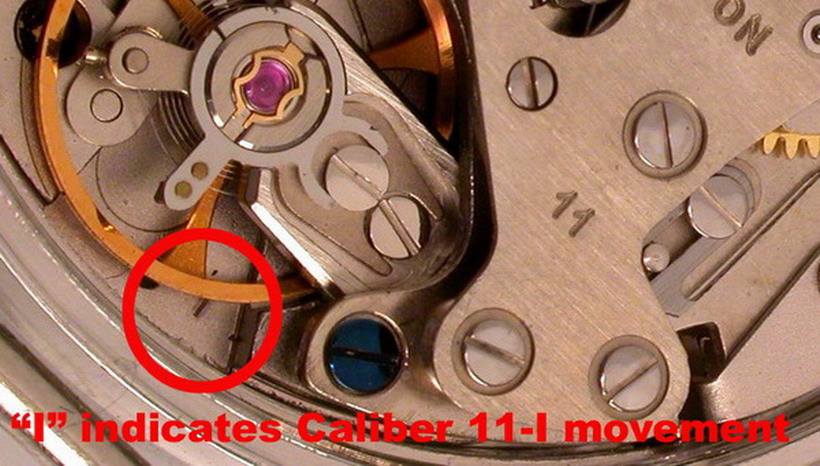
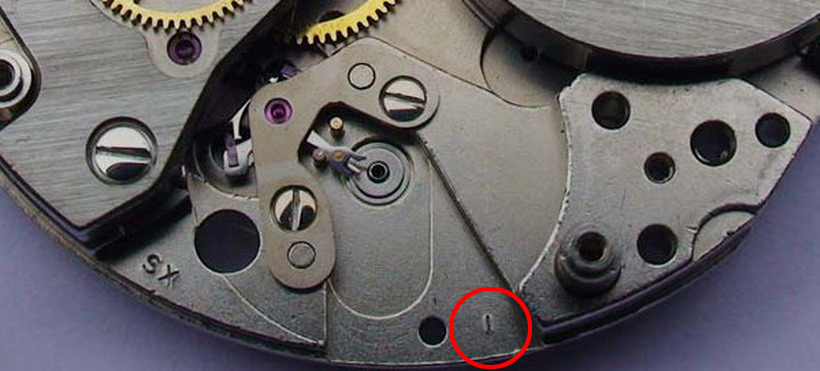
|
|
|
Caliber
11-I has "Arrow" Marks on Back of
Lugs
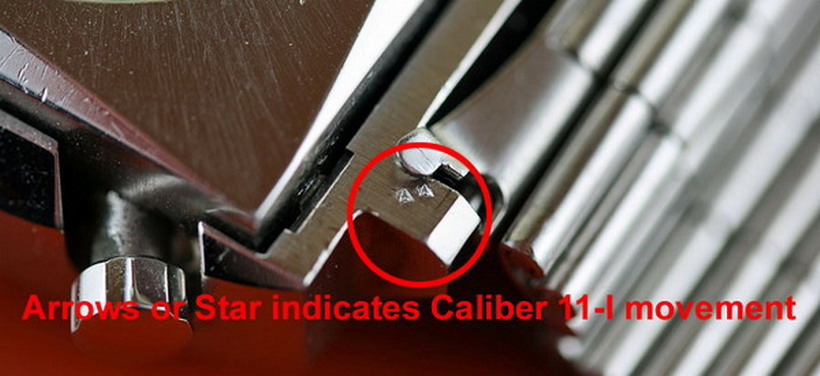
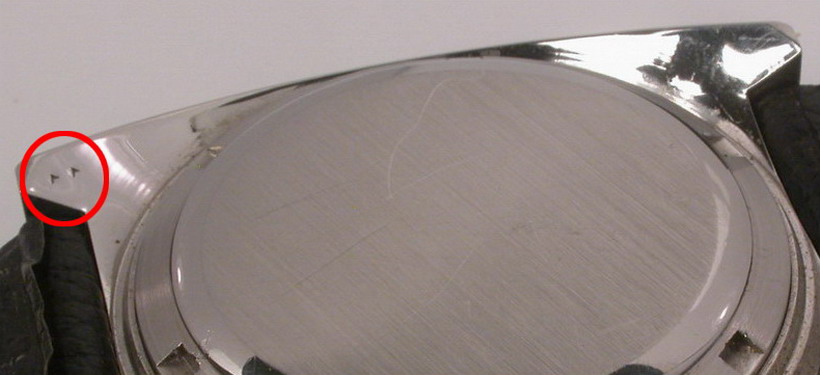
|
|
Jumper
springs (8270 and 8705) are larger
(heavier) on Caliber 11 (above);
smaller (lighter) on Caliber 11-I and
Caliber 12 (below)
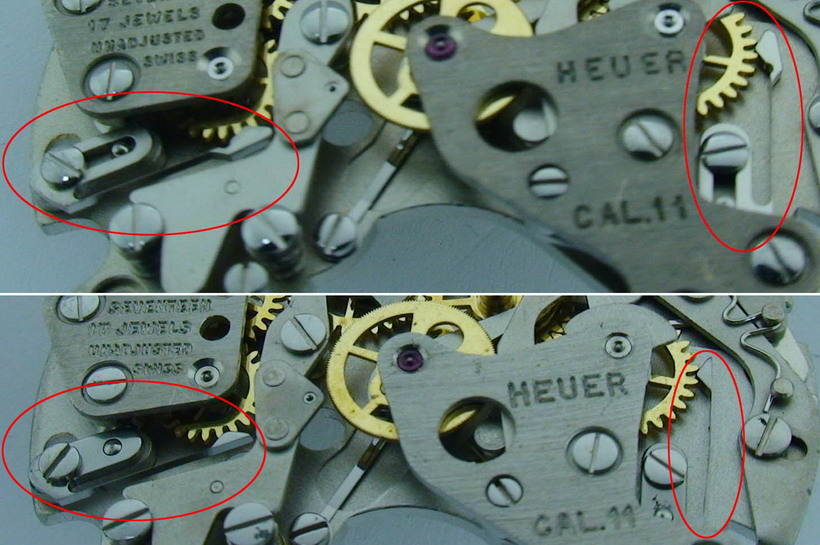
|
|
Date
indicator driving wheel (2556) provides
for rapid date change on Caliber
11;
slower, more gradual date change on
Caliber 11-I and Caliber
12
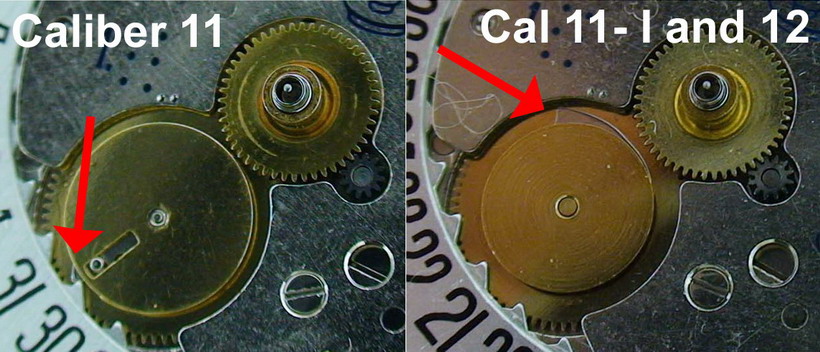
|
|
Barrel
(180) is rose colored on Caliber 11
(above and left);
nickel-plated on Caliber 11-I and
Caliber 12 (below and right)
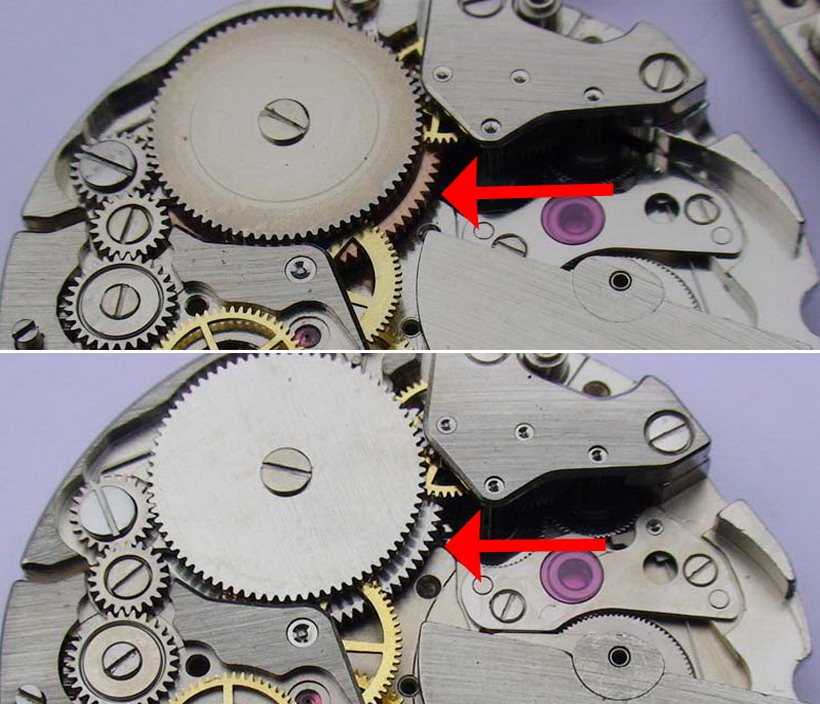
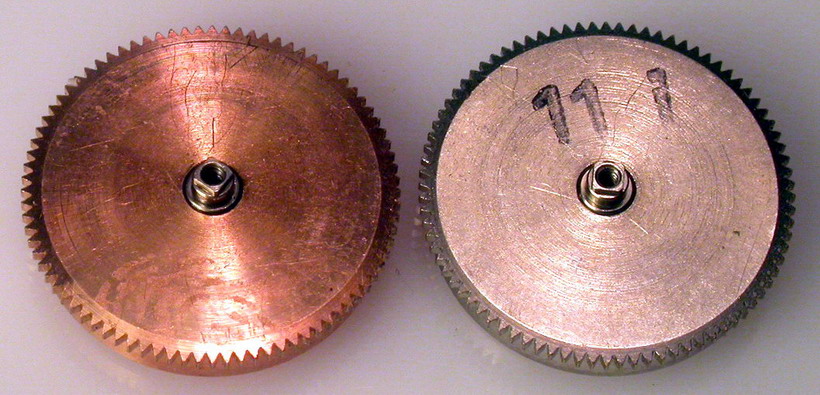
|
|
Mainspring
in the Caliber 11 is too strong (which
contributed to banking);
mainspring in Caliber 11-I and 12
is weaker, so that watch keeps proper
time
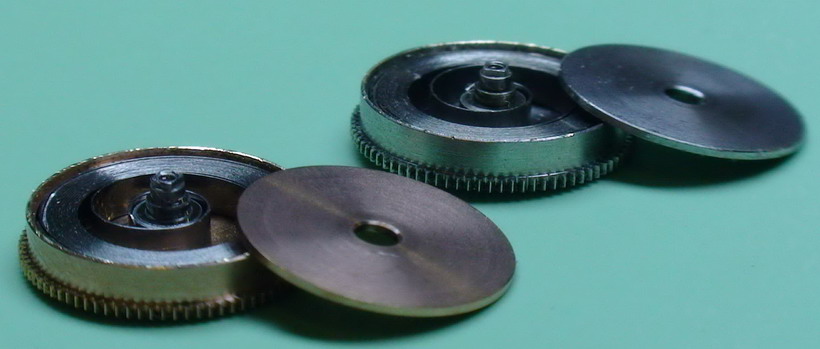
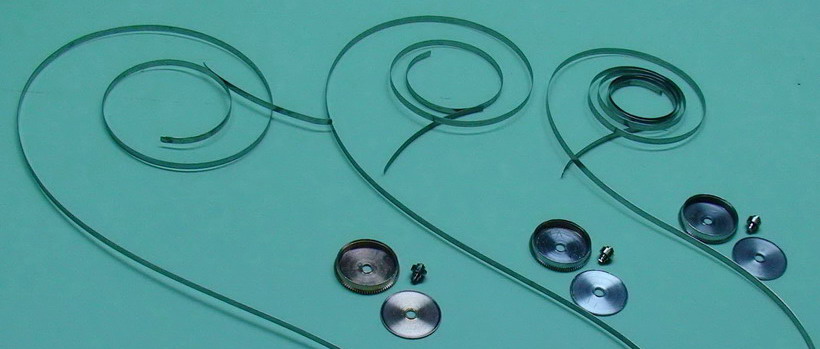
|
|
|
Oscillating
Pinion
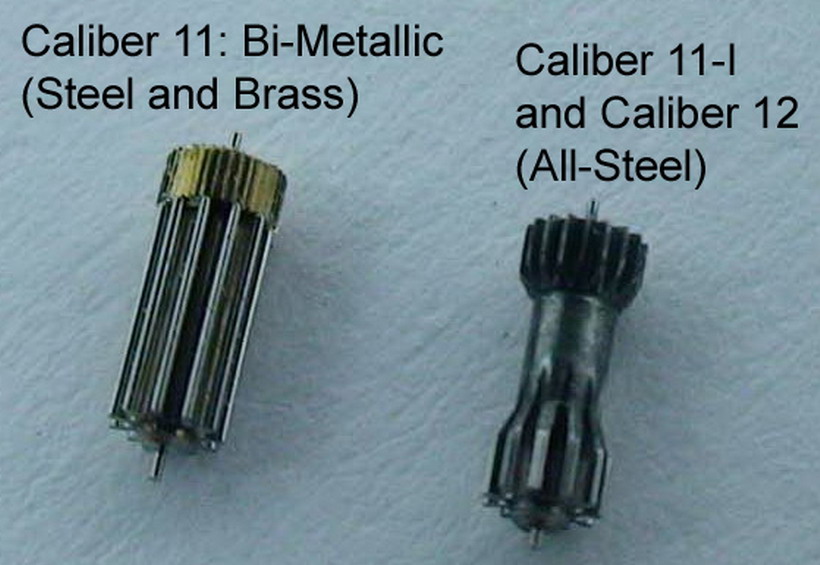
|
|
|
The
hammer (8220) in the Caliber 12 was
redesigned and enlarged, so that the
hammer cam jumper (8356) is held in
place between the "head" of the
hammer (8220) and the main chronograph
plate (8281). The hole in the head
allows for oiling.
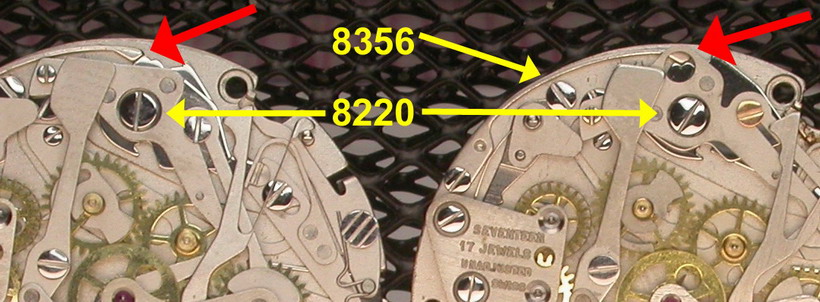
|
|
|
Three
differences between the Caliber 12 and
the Caliber 15 include, (A) the Caliber
12 uses a Glucydur balance, and the
Caliber 15 uses a brass balance, (B)
the Caliber 12 uses Incabloc shock
protection, and the Caliber 15 uses a
KIF system, and (C) the Caliber 12
has fine (micro) tuning in its
regulation (through two screws on the
balance bridge), and the Caliber 15
does not provide for micro
regulation.
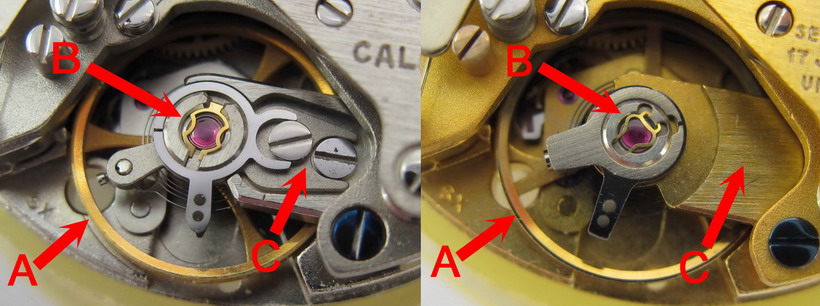
|
|
|
|
|
Last
Updated: 2009.10.07 JMS
|
|